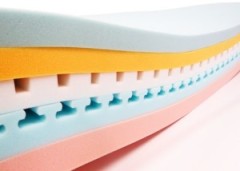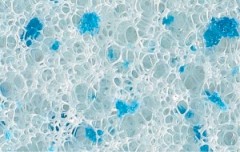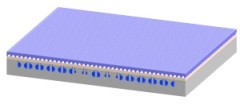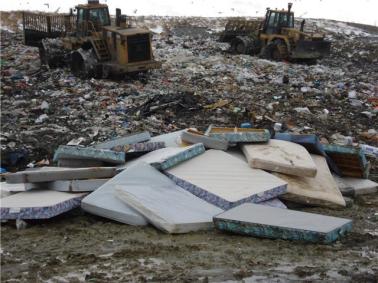A decade ago, who would’ve guessed that foam and latex suppliers would be using words like “magic” and “sizzle” to describe their offerings? But they are. Mattress manufacturers seeking to add pizazz to their lineups have embraced all types of specialty foams. Today’s foams are available in beautiful colors, cuts, convolutions and coring with myriad technical attributes—and they sleep cooler than ever before, suppliers say.

Layered cake look in foam bedding and hybrid bedding
Indeed, solving consumer complaints about foam and temperature regulation has been job one. The result is that foam and latex are plumping up and filling out mattresses in higher proportions than ever before.
FoamPartner Group, a division of Fritz Nauer AG with headquarters in Wolfhausen, Switzerland, stopped traffic with its concept beds that use six or seven varieties of vividly colored foams that include rod and sphere shapes.
“It’s all about function, zoning and being visually attractive,” says Rita Kollbrunner, FoamPartner Group head of marketing and communications. “We aren’t just pouring foam. Our customers look to us to help them tell a story to their customers with pictures, marketing materials and a brand.”
Back in the United States, BedTimes spoke with Carpenter Co., which says it’s seeing steady growth and potential for its Ergonomic Performance engineered cores.
“Engineered cores got their start in Europe, and we’re seeing strong growth here, especially with ones that work well with articulating (adjustable) bases,” says Bob Steelman, vice president of sales and marketing for the Richmond, Va.-based company. “Engineered cores have lots of eye appeal and offer posturized support through special cuts, contours, layers and coring.”
It’s true, suppliers say. Foams add fascination to beds, giving them a certain glamour on the sales floor.
More, More More!

Cool close-up. Elite Foam is a more breathable visco-elastic foam that is very open cell infused with microgel particles.
“We are seeing manufacturers invest in more foams and better quality foams,” says Rick Anthony, director of sales for HSM Bedding Solutions headquartered in Hickory, N.C. “In years past, the 1.2-pound foam was the standard comfort layer in a quilted, traditional mattress. Today, we’re seeing 1.4-pound to 1.8-pound better quality foams and, in specialty bedding, better quality foams from the bottom up. When you’re trying to command higher price points, you’ve got to substantiate it with better quality foams.”
It’s now a given that mattress brands offer one or more all-foam collections, suppliers say. What’s new is the amount of foam being used in beds.
“We did consumer research and found that even if they can’t afford a $4,000 specialty bed, everyone wants a little of ‘the magic that goes on top.’ They’ll buy a hybrid mattress with latex or some other foam on top,” says Kurt Ling, chief executive officer of Pure LatexBLISS, the finished mattress division of supplier Latex International in Shelton, Conn.

Totally Tubular.Companies are now pouring latex in vertical cyclinders as well as horizontal tubes for improved airflow.
Major brands such as Sealy and Simmons have created mattresses that are essentially half foam and half innerspring. The beds have a short foam-encased pocket spring topped with multiple layers of foams. Today’s latex hybrids use more latex, and all-latex beds have become more common.
“In the coming months, thanks to interest in hybrid beds, you’re going to see more and more major manufacturers introducing 3 and 4 inches of latex in a hybrid bed.” It’s gotten to the point where we have three types of hybrid beds today—innerspring with visco, innerspring with latex, and innerspring with visco and latex. And, in general, a whole lot more producers are making all-latex models compared with five years ago. You’ll see what I mean at the January market in Las Vegas.
How cool is that?
Across the board, “foamers” are determined to vanquish consumer perceptions that foam beds “sleep hot.”
Foam introductions are chemically formulated to have very open cells. They are reticulated. They are perforated, channeled, cut and contoured for improved airflow.

Animated Airflow. This ergonomic performance core has multiple layers and maximum breath-ability.
At Interzum Cologne, the company introduced Breeze, a line of two polyurethane foams that includes a high-resiliency foam and a visco-elastic foam that are “substantially more breathable.” Breeze visco-elastic foam is highly porous, has a fast response and is nonreactive to temperature changes, according to the company.
Carpenter has the capability to pinhole core any foam or engineered core at all of its plants.
“We’re on the forefront of breathability with our Active Air Technology—it’s one way to mechanically open foam up to allow air circulation,” Steelman says. “Coring also reduces moisture.”
David Wright, vice president of Elite Foam, which pours and fabricates specialty foams and is based in Newnan, Ga., says he sees more interest in surface-modified foams and pinhole coring of all foams to improve ventilation.
“Our main focus in new product development is improving comfort and thermal regulation,” he says. “We’ve created a more open-cell visco that is 10 times more breathable than regular memory foam.”
Gel vs phase change – or both?
In Europe, where all-foam mattresses dominate the marketplace, gel foams haven’t taken off as they have in other markets. In the United States and Canada, most better foam and hybrid mattresses contain some element of poured gel or gel-infused visco or latex. Some U.S. foamers say that gel has “reached a saturation point”; others say it will continue to be popular at the top of the mattress.
While gel products are good for pressure relief, in Europe you will find they are not as popular as in the United States. For temperature regulation, we prefer foams with phase-change material. “Gel foam is trending in Europe, but we consider the cooling properties unproven,” says Dennes Need, sales manager of Draka Interfoam.
“We do know that gel has orthopedic properties; it’s proven to add comfort and pressure relief and that it is more resilient,” Need says. The use of phase-change material in foams is growing in the United States, too.
New angles on sustainability

Flow-through foam allows heat and moisture to wick away from sleepers.
In foam production, most of the sustainability discussion has shifted to manufacturing practices and product life cycle. Manufacturers and the public, however, continue to be “interested in what’s in the foam and what’s in their bed,” Crowell says.
U.S.-based foamers mentioned the importance of CertiPUR-US, a foam certification process that ensures product quality, durability and safety, as well as sustainable manufacturing practices and indoor emission reduction. (It’s based on a similar certification in Europe.)
“The Earth’s natural systems cannot absorb all this back and a good portion remains in the atmosphere, interfering with our climate,” he says. “Simply put, the rubber tree is among the top natural C02 absorbers and its yield, latex, is predominantly made of carbon—carbon absorbed from the atmosphere. When you make a natural latex mattress, you promote the growth of rubber trees. When you assess the amount of C02 that rubber trees have absorbed to create latex for a mattress and set it against all the greenhouse gas emissions released during the manufacture of that mattress, it’s negative—the whole process of manufacturing, procuring and using this mattress creates a reversal of atmospheric pollution. (This equation is based on the testing of unique formulas we have derived, published data on carbon sequestration of rubber trees, and a comprehensive assessment of greenhouse gas inventory under ISO 14064 standards at our factories.)
More sizzle coming soon
Foamers have a slew of new products in the pipeline and hint at more introductions blending latex, visco-elastic and traditional foams. These foams will be focusing on pressure relief, cushioning and support.






















